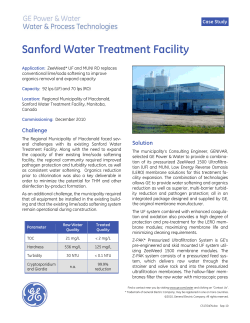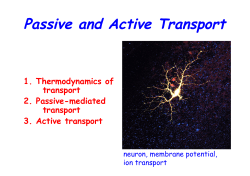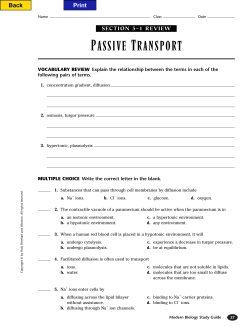
PERVAPORATION
MEMBRANE PROCESSES – Vol. II – Pervaporation - R.W. Baker and J.G. Wijmans PERVAPORATION R.W. Baker and J.G. Wijmans Membrane Technology and Research, Inc. Menlo Park, CA, USA Keywords : Equipment Design, Modules, Pervaporation, Peclet Number, Polarization Contents U SA NE M SC PL O E – C EO H AP LS TE S R S 1. Introduction 2. Fundamentals of Pervaporation 3. Membranes and Modules 4. Process and Equipment Design 4.1. Concentration Polarization 4.1.1. Measurement of the Peclet Number 4.1.2. Effect of Membrane Type and Membrane Thickness 4.1.3. Effect of Permeate Pressure 4.2. Process Design 5. Applications of Pervaporation 5.1. Wastewater Treatment 5.2. Treatment of Fine Chemicals/Pharmaceuticals Process Streams 5.3. Food Industry Applications 6. Conclusions and Future Directions Bibliography and Suggestions for further study Summary Pervaporation is a membrane process used to separate liquid mixtures. The process offers the possibility of separating solutions, mixtures of components with close boiling points, or azeotropes that are difficult to separate by distillation or other means. Treatment of volatile organic compounds (VOCs) containing water by pervaporation, the focus of this article, is at the early industrial stage; the first plants were installed in 1996. Applications exist in pollution control and aroma and flavor recovery from wastewater in the food industry. The most competitive conventional technology is stream stripping. Pervaporation appears to be the preferred process for relatively small volume streams (<10-20 gallons min-1) and streams where the VOC to be recovered is thermally labile (e.g. flavor compounds). Experience with these plants show the process is dominated by concentration polarization effects. Pervaporation membranes are often 1000 times more permeable to VOCs than to water, so the layer of solution next to the membrane surface becomes depleted of VOC, lowering the flux and the selectivity of the membrane. Concentration polarization effects can be controlled but not eliminated by appropriate module and process design. Current pervaporation membranes are generally composite structures consisting of a thin rubbery layer of selective membrane material supported on a microporous support. © Encyclopedia of Desalination and Water Resources (DESWARE) MEMBRANE PROCESSES – Vol. II – Pervaporation - R.W. Baker and J.G. Wijmans The membranes are usually formulated into plate-and-frame or spiral-wound membrane modules. These membranes are very selective for hydrophobic organics such as chlorinated solvents, aromatics and esters but better membranes are required for hydrophilic organics such as ethanol, methanol, and acetic acid. 1. Introduction U SA NE M SC PL O E – C EO H AP LS TE S R S Pervaporation is a membrane process used to separate liquid mixtures. A schematic diagram of the process is shown in Figure 1. The feed liquid contacts one side of a membrane, which selectively permeates one of the components. The permeate, enriched in this component, is removed as a vapor from the other side of the membrane. The driving force for the process is the low pressure generated by cooling and condensing the permeate vapor. The separation achieved is proportional to the rate of permeation of the components of the mixture through the membrane. Pervaporation, therefore, offers the possibility of separating solutions, mixtures of components with close boiling points, or azeotropes that are difficult to separate by distillation or other means. Figure 1. In the pervaporation process, a liquid contacts the membrane, which preferentially permeates one of the components as a vapor. The permeate is cooled and condensed, spontaneously generating a vacuum that drives the process. The first systematic work on pervaporation was done by Binning et al. at American Oil in the 1950s (Binning et al. 1961). The process was not commercialized at that time and © Encyclopedia of Desalination and Water Resources (DESWARE) MEMBRANE PROCESSES – Vol. II – Pervaporation - R.W. Baker and J.G. Wijmans remained a mild academic curiosity until 1982, when GFT (Gesellschaft für Trenntechnik GmbH, Germany) installed the first commercial pervaporation plant (Ballweg et al. 1982, Tusel and Brüschke 1985). The plant separated water from concentrated alcohol solutions; GFT has since installed more than 100 such plants. The ethanol feed to the membrane generally contains about 10 per cent water. The pervaporation process removes the water as the permeate, producing pure ethanol with less than 1 per cent water. All the problems of azeotropic distillation are avoided. U SA NE M SC PL O E – C EO H AP LS TE S R S Spurred on by this success, a great deal of effort is being made to apply pervaporation to other difficult separations. Exxon, for example, has pursued the separation of hydrocarbon mixtures containing aromatics and aliphatics, a major separation problem in refineries (Schucker et al. 1991-1995). This article focuses on another application of pervaporation - the separation of dissolved volatile organic compounds (VOCs) from water (Burn et al. 1985, Wijmans et al. 1988, Blume et al. 1990, Böddeker et al. 1990, Hollein et al. 1993). The first commercial pervaporation plants for VOC recovery and removal were installed in 1996. - TO ACCESS ALL THE 36 PAGES OF THIS CHAPTER, Visit: http://www.desware.net/DESWARE-SampleAllChapter.aspx Bibliography and Suggestions for further study Athayde A L, Baker R W, Daniels R, Le M and Ly J H (1997) Pervaporation for wastewater treatment. CHEMTECH 27, 34-39. Baker R W, Wijmans J G, Athyade A L, Daniels R, Ly J H and Le M (1997) The effect of concentration polarization on the separation of volatile organic compounds from water by pervaporation. Journal of Membrane Science 137, 159. Ballweg A H, Brüschke H E A, Schneider W H and Tusel G F (1982) Pervaporation Membranes. (Proceedings of the Fifth International Alcohol Fuels Symposium, Auckland, New Zealand). Dunedin: John McIndoe. Bell C-M, Gerner F-J and Strathmann H (1988) Selection of polymers for pervaporation membranes. Journal of Membrane Science 36, 315-329. Binning R C, Lee R J, Jennings J F and Martin E C (1961) Separation of liquid membranes by permeation. Industrial and Engineering Chemistry Research 53, 45. Blume I and Baker R W (1990) Treatment of Evaporator Condensates by Pervaporation. US Patent 4,952,751. Blume I and Baker R W (1991) Process for Recovering Organic Components from Liquid Streams. US Patent 5,030,356. Blume I, Wijmans J G and Baker R W (1990) The separation of dissolved organics from water by pervaporation. Journal of Membrane Science 49, 253. Böddeker K W and Bengtson G (1991) Selective Pervaporation of Organics from Water Pervaporation © Encyclopedia of Desalination and Water Resources (DESWARE) MEMBRANE PROCESSES – Vol. II – Pervaporation - R.W. Baker and J.G. Wijmans Membrane Separation Process. Amsterdam, The Netherlands: Elsevier. Böddeker K W, Bengtson G and Bode E (1990) Pervaporation of low volatility aromatics from water. Journal of Membrane Science 53, 143-158. Brian P L T (1966) Mass Transport in Reverse Osmosis Desalination by Reverse Osmosis, 181 pp. Cambridge, MA: Merten. Brun J-P, Harchet J, Bulvestre B and Auclair B (1985) Sorption and pervaporation of dilute organic compounds through polymer membranes. Journal of Membrane Science 25, 55. Côté P and Lipski C (1988) Mass Transfer Limitations in Pervaporation for Water and Wastewater Treatment (Proceedings of the Third International Conference on Pervaporation in the Chemical industry, Nancy, France) (ed. R. Bakish), pp. 449-462. Englewood, NJ: Bakish Materials Corporation. Feng X and Huang R Y M (1994) Concentration polarization in pervaporation separation processes. Journal Membrane Science 92, 201-208. U SA NE M SC PL O E – C EO H AP LS TE S R S Fontalvo Alzate, Javier (2006). Design and performance of two-phase flow pervaporation and hybrid distillation process.. Technische Universiteit Eindhoven, The Netherlands: JWL boekproducties General Electric Corporation Brochure (1982) General Electric PermSelective Membranes, General Electric Schenectady, New York. Gooding C H, Hickey P J, Dettrenberg D and Cobb J (1992) Mass Transfer and Permeate Pressure Effects in the Pervaporation of VOCs from Water (Proceedings of the Sixth International Conference on Pervaporation in the Chemical Industry, Ottawa, Canada) (ed. R. Bakish), pp. 80-87. Englewood, NJ: Bakish Materials Corporation. Greenlaw F W, Prince W D, Shelden R A and Thompson E V (1977) The effect of diffusive permeation rates by upstream and downstream pressures. Journal of Membrane Science 2, 141. Hollein M E, Hammond M and Slater C S (1993) Concentration of dilute acetone-water solutions using pervaporation. Separation Science and Technology 28, 1043. Jia M-D, Peinemann K-V and Behling R-D (1992) Preparation and characterization of thin film zeolite PDMS composite membranes. Journal of Membrane Science 73, 119-128. Karlsson H O E and Trägårdth G (1993) Pervaporation of dilute organic-water mixtures. A literature review on modelling studies and applications to aroma compound recovery. Journal of Membrane Science 76, 121-146. Karlsson H O E and Trägårdth G (1996) Applications of pervaporation in food processing. Trends in Food Science and Technology 7, 78-83. Lipski C, Côté P and Fleming H (1991) Transverse Feed Flow for Hollow Fibers Significantly Improves Mass Transfer at Low Energy Consumption (Proceedings of Fifth International Conference on Pervaporation Processes in the Chemical Industry) (ed. R. Bakish), pp. 134-140. Englewood, NJ: Bakish Materials Corporation. Matuschewski, Heike (2008). MSE — modified membranes in organophilic pervaporation for aromatics/aliphatics separation.. www.desline.com: Desalination Meckl K and Lichtenthaler R N (1992) Hybrid Processes including Pervaporation of Organic Compounds from Process and Wastewater (Proceedings of the Sixth International Conference on Pervaporation Processes in the Chemical Industry, Ottawa, Canada) (ed. R. Bakish), pp. 476-483. Englewood, NJ: Bakish Materials Corporation. Nijhuis N H, Mulder M H V and Smolders C A (1988) Selectivities of Elastomeric Membranes for the Removal of Volatile Organic Components from Water (Proceedings of the Third International Conference on Pervaporation in the Chemical Industry, Nancy, France) (ed. R. Bakish), pp. 239-245. Englewood, NJ: Bakish Materials Corporation. Schucker, R C et al., US Patents 4,430,224 (1995): 5,075,006 (1991); 5,063,186 (1991); 5,055,632 (1991); 5,049,281 (1991). te Hennepe H J C, Bargeman D, Mulder M H V and Smolders C.A (1987) Zeolite-filled silicone rubber © Encyclopedia of Desalination and Water Resources (DESWARE) MEMBRANE PROCESSES – Vol. II – Pervaporation - R.W. Baker and J.G. Wijmans membranes. Journal of Membrane Science 35, 39-55. Toraj Mohammadi, Afshin Pak (2003)Effect of calcination temperature of kaolin as a support for zeolite membranes Separation and Purification Technology, Volume 30, Issue 3,Pages 241-249 Travis C. Bowen, Richard D. Noble, John L. Falconer(2004),Fundamentals and applications of pervaporation through zeolite membranes Journal of Membrane Science, Volume 245, Issues 1-2, , Pages 1-33 Travis C. Bowen, Shiguang Li, Richard D. Noble, John L. Falconer(2003), Driving force for pervaporation through zeolite membranesJournal of Membrane Science, Volume 225, Issues 1-2,Pages 165-176 Travis C. Bowen, Shiguang Li, Vu A. Tuan, John L. Falconer and Richard D. Noble (2002),Pervaporation of aqueous organic mixtures through Ge-ZSM-5 zeolite membranes,DesalinationVolume 147, Issues 1-3, , Pages 327-329 U SA NE M SC PL O E – C EO H AP LS TE S R S Tusel G F and Brüschke H E A (1985) Use of pervaporation systems in the chemical industry. Desalination 53, 327-338. Wijmans J G and Baker R W (1993) A simple predictive treatment of the permeation process in pervaporation. Journal of Membrane Science 79, 101-113. Wijmans J G, Athayde A L, Daniels R, Ly J H, Kamaruddin H D and Pinnau I (1996) The role of boundary layers in the removal of volatile organic compounds from water by pervaporation. Journal of Membrane Science 109, 135-146. Wijmans J G, Kaschemekat J H, Davidson J E and Baker R W (1990) Treatment of organic-contaminated wastewater streams by pervaporation. Environmental Progress 9, 262-268. Will B and Lichtenthaler R N (1991) Comparison of the Separation of Aqueous Mixtures by Vapor Permeation and by Pervaporation (Proceedings of the Fifth Industrial Conference on Pervaporation Process in the Chemical Industry, Heidelberg, Germany) (ed. R. Bakish), pp. 216-229. Englewood, NJ: Bakish Materials Corporation. © Encyclopedia of Desalination and Water Resources (DESWARE)
© Copyright 2025










